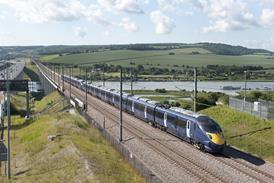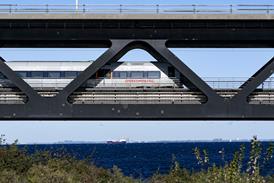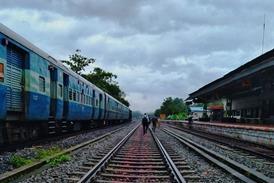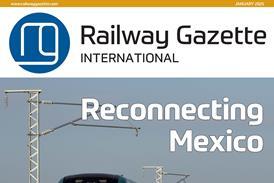AN UNOFFICIAL world rail speed record of 554?3?km/h was set in France on February 13 during trials on TGV Est. This comprehensively beats the 515?3?km/h rail record that SNCF established on May 18 1990 and surpasses the 552?km/h achieved by the Japanese experimental maglev trainset MLX01 at Yamanashi on April 14 1999. The run by a five-car double-deck TGV uprated to 20?MW formed part of an SNCF-RFF-Alstom joint research programme into higher speeds (RG 1.06 p17) that is expected to culminate on April 5 with an ’official’ attempt to lift the record by 10% to a speed of around 570 km/h. SNCF Chief Executive Guillaume Pepy sees higher speeds as an essential element in making Europe’s railways more competitive, suggesting on February 8 that ’today we have the opportunity to shape the industry at a critical time’. Giving the annual Sir Robert Reid lecture to the Chartered Institute of Logistics & Transport in London, he pointed out that there was ’a colossal level of investment going into high speed lines now’, estimating that k150bn would be spent over the next 15 years. Evidence from several countries indicated that construction of high speed lines increases rail’s share of the rail+air market by a factor of three, he confirmed. With world oil reserves expected to last 43 years and traffic congestion estimated to waste 1% of Europe’s entire GDP, or k90bn a year, Pepy forecast that high speed rail would play a greater role in the future mobility mix. With the journey time threshold for effective competition with air moving from 3?h to between 4?h and 4??h, ’when a journey by train is less than 4? h, our share of the market is over 50%.’ Quoting Air France Chairman Jean-Cyril Spinetta’s view that ’it is the TGV which is the low-cost carrier’, Pepy said an aggressive pricing policy and yield management had enabled SNCF to increase its customer base by 12% in the first year and improve its operating margin by 8%. Fares for the 750?km journey from Paris to Marseille now range from k25 to k130, and the average load factor of the 680 TGV services operated each day has reached 71%. To meet increasing demand, Pepy expects SNCF to double its 430-strong TGV fleet within 25 years. Orders already placed will see 15 TGV Duplex sets delivered each year until 2009, but after that he is looking to move to a totally new design. ’We have an incredible opportunity to rethink our strategy’, he said, questioning whether to stick with articulation, and whether to switch from separate power cars to distributed traction. A clear target is reliability. Today the TGV Duplex fleet averages ’six incidents per million km, which is good. But 60 times worse than Shinkansen’. SNCF plans to order 300 to 400 new trains for delivery in 2015-50, and Pepy said the next invitation to tender would be valued at k6bn to k9bn. The trains will be designed for 320 or 350?km/h operation, but that is not the limit of his vision. Noting that ’Paris - Lyon is now almost at saturation point’ with a realistic limit of 13 trains/h each way, he suggested that ’we should ask how to double line capacity in the next 20 years’. One option might be to build a second high speed line, where 360?km/h operation ’would allow a time saving of 25%, moving from 2?h to 1??h’, which would in turn generate more traffic. He confirmed that the current research is aimed at a commercial speed of 360?km/h, which he compared to JR East’s Fastech programme. ’So is the next step 360?km/h? Perhaps.’ But his comments suggest that a long-term vision of a 500 km/h TGV is already starting to take shape. n
- News
- In depth
- Events
- Maps & Data
- Magazines
- Tenders & Jobs
 Locomotives, Vehicles & Railway Assets from Transport for London are set for Auction
Locomotives, Vehicles & Railway Assets from Transport for London are set for Auction RFI- Rescue Trains
RFI- Rescue Trains RFI- Technological Solution of Train Gauge Measurement Gates
RFI- Technological Solution of Train Gauge Measurement Gates Solutions for Fuel Alternatives – For consumption, Train Transport, Logistics, and Operations: Challenge tender No. 42235 Proposal Invitation
Solutions for Fuel Alternatives – For consumption, Train Transport, Logistics, and Operations: Challenge tender No. 42235 Proposal Invitation
- Sponsored content
















